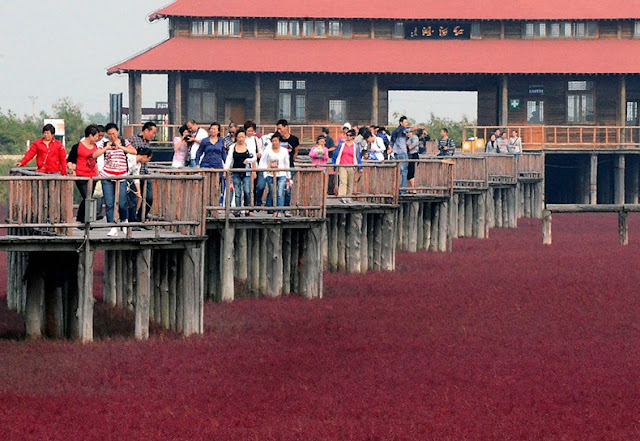Covering an area of nearly 600,000 hectares, the Liaohe River Delta Marshland includes Panjin and Yingkou Cities in Liaoning Province, where the Shuangtai Hekou Nature Reserve has been set up. This is a key habitat and a way station for migratory birds on their East Asia-Australia route. The endless stretch of its unique ''red carpet'', the world's second-largest reed marshes, such as red-crowned cranes, black-beaked gulls and sounders' gulls, and spotted and common seals, are parts of a richly colorful wetland ecosystem.
There lives a plant with strong life force in the mud flat of the mouth of Liaohe River. It calls the sea-blite plants. The sea-blite plants start to grow in every April or May. The color is green at beginning, and becomes red slower and slower. In September, the colors of the plants become strong red, covering the whole alkaline beach. The splendid red beach scenery appears only at the mud flat in Panjin. Although sea-blite plants grow in other coastal areas, the plants couldn’t become red at last there. Therefore, it has a beautiful name- Red Beach.
There are 236 kinds of birds inhabit here. Among them, there are over 30 kinds of national first and second class protection birds, such as red-crowned cranes, black-mouth gulls, etc. Therefore, the red beach scenic area becomes a national nature protection area. It has been the gold tourist section of Liaohe area, because of its rich nature resources and beautiful nature spectacle. The mud flat occupies the area of over 90,000 Mu. When tide covers the mud flat, haulms of reeds could still been seen. After tide, the whole area appears a red spectacle again, which looks like burning red clouds in the beach. Moreover, the red beach is listed on the international tourist routes. More and more people are attracted by the fantastic red beach not only at home but abroad.
There lives a plant with strong life force in the mud flat of the mouth of Liaohe River. It calls the sea-blite plants. The sea-blite plants start to grow in every April or May. The color is green at beginning, and becomes red slower and slower. In September, the colors of the plants become strong red, covering the whole alkaline beach. The splendid red beach scenery appears only at the mud flat in Panjin. Although sea-blite plants grow in other coastal areas, the plants couldn’t become red at last there. Therefore, it has a beautiful name- Red Beach.
There are 236 kinds of birds inhabit here. Among them, there are over 30 kinds of national first and second class protection birds, such as red-crowned cranes, black-mouth gulls, etc. Therefore, the red beach scenic area becomes a national nature protection area. It has been the gold tourist section of Liaohe area, because of its rich nature resources and beautiful nature spectacle. The mud flat occupies the area of over 90,000 Mu. When tide covers the mud flat, haulms of reeds could still been seen. After tide, the whole area appears a red spectacle again, which looks like burning red clouds in the beach. Moreover, the red beach is listed on the international tourist routes. More and more people are attracted by the fantastic red beach not only at home but abroad.










